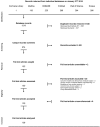A systematic review of image segmentation methodology, used in the additive manufacture of patient-specific 3D printed models of the cardiovascular system
- PMID: 27170842
- PMCID: PMC4853939
- DOI: 10.1177/2048004016645467
A systematic review of image segmentation methodology, used in the additive manufacture of patient-specific 3D printed models of the cardiovascular system
Abstract
Background: Shortcomings in existing methods of image segmentation preclude the widespread adoption of patient-specific 3D printing as a routine decision-making tool in the care of those with congenital heart disease. We sought to determine the range of cardiovascular segmentation methods and how long each of these methods takes.
Methods: A systematic review of literature was undertaken. Medical imaging modality, segmentation methods, segmentation time, segmentation descriptive quality (SDQ) and segmentation software were recorded.
Results: Totally 136 studies met the inclusion criteria (1 clinical trial; 80 journal articles; 55 conference, technical and case reports). The most frequently used image segmentation methods were brightness thresholding, region growing and manual editing, as supported by the most popular piece of proprietary software: Mimics (Materialise NV, Leuven, Belgium, 1992-2015). The use of bespoke software developed by individual authors was not uncommon. SDQ indicated that reporting of image segmentation methods was generally poor with only one in three accounts providing sufficient detail for their procedure to be reproduced.
Conclusions and implication of key findings: Predominantly anecdotal and case reporting precluded rigorous assessment of risk of bias and strength of evidence. This review finds a reliance on manual and semi-automated segmentation methods which demand a high level of expertise and a significant time commitment on the part of the operator. In light of the findings, we have made recommendations regarding reporting of 3D printing studies. We anticipate that these findings will encourage the development of advanced image segmentation methods.
Keywords: 3D printing; Computed tomography and magnetic resonance imaging; cardiovascular surgery; diagnostic testing; image segmentation; paediatric and congenital heart disease.
Figures




References
-
- Schaffer M. Spectrum of congenital cardiac defects. In: Da Cruz EM, Ivy D, Jaggers J. (eds). Pediatric and congenital cardiology, cardiac surgery and intensive care, London: Springer, 2013, pp. 1419–1123–1419–1123.
-
- Moons P, Sluysmans T, De Wolf D, et al. Congenital heart disease in 111 225 births in Belgium: birth prevalence, treatment and survival in the 21st century. Acta Pædiatr 2009; 98: 472–477. - PubMed
-
- Kim MS, Hansgen AR, Carroll JD. Use of rapid prototyping in the care of patients with structural heart disease. Trends Cardiovasc Med 2008; 18: 210–216. - PubMed
-
- Costello JP, Olivieri LJ, Su L, et al. Incorporating three-dimensional printing into a simulation-based congenital heart disease and critical care training curriculum for resident physicians. Congenital Heart Dis 2015; 10: 185–190. - PubMed
LinkOut - more resources
Full Text Sources
Other Literature Sources
Research Materials
Miscellaneous

